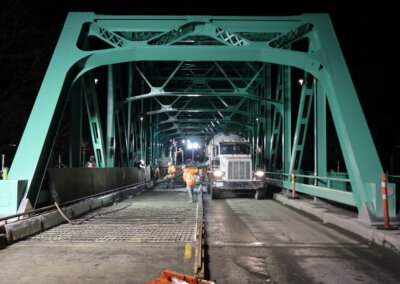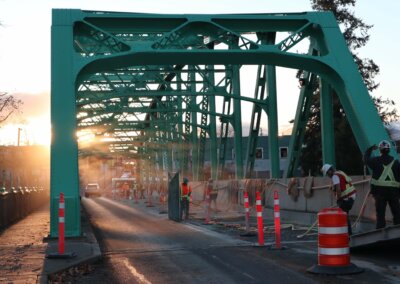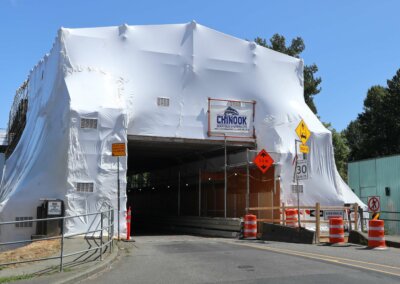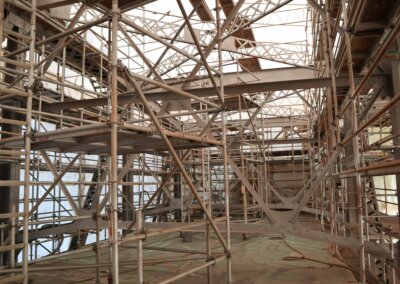About the Project
The 5th Street Bridge in Courtenay, BC is a vital component of the City of Courtenay’s infrastructure and an important local landmark. It is situated on one of the main thoroughfares in the heart of the city. The 72m span steel truss bridge is one of only two pedestrian and vehicle crossing points on the Courtenay River, providing a transportation link to the communities and businesses located east of Courtenay in the Comox Valley. The bridge was constructed in 1960 and despite regular maintenance, the bridge was approaching the end of its service life.
The project began with a multi-consultant feasibility study which considered replacement with a concrete bridge and various rehabilitation options of the existing structure. A major factor in the study was that the bridge sees volumes of traffic of up to 20,000 vehicles, 160 buses, 650 pedestrians and 500 cyclists per day. In consultation with the City of Courtenay, it was apparent that a full closure of the bridge was not feasible due to the social, economic, and emergency vehicle impacts. Therefore, a rehabilitation option was chosen.
The project involved traffic management, environmental management, lead coating abatement, structural steel repairs, concrete deck repair, installation of a high-performance concrete overlay with an integral impressed current cathodic protection system (ICCP); all while maintaining single lane alternating traffic. This scope required a multidiscipline consulting team of Thurber, Urban Systems, and Hatch using innovative engineering solutions.
Approach
The rehabilitation approach was chosen primarily based on a required 40 -year service life extension while maintaining continuous access across the bridge. The structural configuration of the bridge along with the advanced deterioration state of the bridge deck limited the options for rehabilitation. Full removal of the deck was not considered feasible while maintaining continuous traffic flow.
These limitations guided the choice for the deck repairs and the containment approach for the lead abatement portion of the work. The negative air containment system was constructed both above and below the superstructure. The containment was designed and constructed in such a way as to allow for abrasive blast removal of lead-based coating and installation of a new coating system less than one metre from public vehicles and pedestrians. Environmental protocols were developed to monitor the project which included daily inspection to monitor the potential release of hazardous materials into the environment.
The continuous use of the bridge also required an innovative solution to retain portions of the deck which were saturated with high levels of chlorides. Thurber selected and determined the design parameters for an ICCP system for the bridge deck and a galvanic system to protect the top of the floor beams. This approach was the second-ever ICCP system for a bridge deck in BC and the first hybrid ICCP and galvanic system used in the province.
Results
After months of construction the deck rehabilitation was completed which allowed for two-way traffic to resume crossing the bridge deck. Monitoring data shows that the ICCP system is functioning as intended. The environmental hazard of the lead coating on the structural steel has been removed. In its place is a high-performance coating system that has been applied to very stringent quality criteria.
Service(s) Provided
Feasibility Assessment
Preliminary Assessment
Coating System Design
Cathodic Protection Design
Structural Design
Tender Development
Traffic Management Planning
Environmental Mitigation Design
Contract Administration
Field Services
Project Team (Contractors)
Park Derochie
Seismic 2000
Go back to projects in
View other projects from
Stay in touch with us
Subscribe to our mailing list!
Organization
Connect






